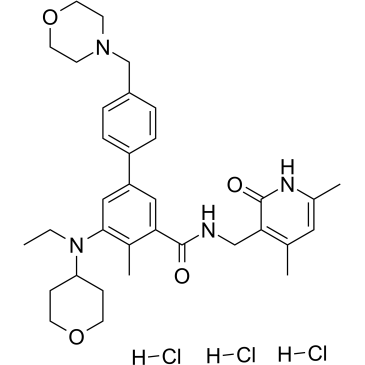Tazemetostat trihydrochloride
Modify Date: 2024-01-07 22:58:25

Tazemetostat trihydrochloride structure
|
Common Name | Tazemetostat trihydrochloride | ||
|---|---|---|---|---|
| CAS Number | 1403255-00-4 | Molecular Weight | 682.12 | |
| Density | N/A | Boiling Point | N/A | |
| Molecular Formula | C34H47Cl3N4O4 | Melting Point | N/A | |
| MSDS | N/A | Flash Point | N/A | |
Use of Tazemetostat trihydrochlorideTazemetostat trihydrochloride (EPZ-6438 trihydrochloride) is a potent, selective and orally available EZH2 inhibitor. Tazemetostat trihydrochloride inhibits the activity of human polycomb repressive complex 2 (PRC2)-containing wild-type EZH2 with a Ki of 2.5 nM. Tazemetostat trihydrochloride inhibits EZH2 with IC50s of 11 and 16 nM in peptide assay and nucleosome assay, respectively. Tazemetostat trihydrochloride inhibits rat EZH2 with an IC50 of 4 nM. Tazemetostat (EPZ-6438) also inhibits EZH1 with an IC50 of 392 nM[1]. |
| Name | Tazemetostat trihydrochloride |
|---|
| Description | Tazemetostat trihydrochloride (EPZ-6438 trihydrochloride) is a potent, selective and orally available EZH2 inhibitor. Tazemetostat trihydrochloride inhibits the activity of human polycomb repressive complex 2 (PRC2)-containing wild-type EZH2 with a Ki of 2.5 nM. Tazemetostat trihydrochloride inhibits EZH2 with IC50s of 11 and 16 nM in peptide assay and nucleosome assay, respectively. Tazemetostat trihydrochloride inhibits rat EZH2 with an IC50 of 4 nM. Tazemetostat (EPZ-6438) also inhibits EZH1 with an IC50 of 392 nM[1]. |
|---|---|
| Related Catalog | |
| Target |
EZH2 WT:2.5 nM (Ki) EZH2:11 nM (IC50, in peptide assay) EZH2:16 nM (IC50, in nucleosome assay) Rat EZH2:4 nM (IC50) EZH1:392 nM (IC50) |
| In Vitro | Tazemetostat (EPZ-6438) inhibits multi wild-type and mutant lymphoma cell lines proliferation with IC50s of 0.49 nM-7.6 μM[1]. Cell Proliferation Assay[1] Cell Line: Wild-type and mutant lymphoma cell lines: DOHH-2 cell (EZH2 wild-type), Farage cell (EZH2 wild-type), OCI-LY19 cell (EZH2 wild-type), Toledo cell (EZH2 wild-type), KARPAS-422 (EZH2 Y646N), Pfeiffer (EZH2 A682G), RL cell line (EZH2 Y646N), SU-DHL-10 (EZH2 Y646F), SU-DHL-6 (EZH2 Y646N), WSU-DLCL2 (EZH2 Y646F) Concentration: 0.49 nM-7.6 μM Incubation Time: 11 days Result: Inhibited DOHH-2 cell (EZH2 wild-type; IC50=1.7 μM), Farage cell (EZH2 wild-type; IC50=99 nM), OCI-LY19 cell (EZH2 wild-type; IC50=6.2 μM), Toledo cell (EZH2 wild-type; IC50=7.6 μM), KARPAS-422 (EZH2 Y646N; IC50=1.8 nM), Pfeiffer (EZH2 A682G; IC50=0.49 nM), RL cell line (EZH2 Y646N; IC50=5.8 μM), SU-DHL-10 (EZH2 Y646F; IC50=5.8 nM), SU-DHL-6 (EZH2 Y646N; IC50=4.7 nM), WSU-DLCL2 (EZH2 Y646F; IC50=8.6 nM) proliferation. |
| In Vivo | Tazemetostat (EPZ-6438; 250 or 500 mg/kg twice daily for 21-28 days) practically eliminates the fast-growing G401 tumors[1]. Animal Model: SCID mice bearing s.c. G401 xenografts[1] Dosage: 125 mg/kg, 250 mg/kg, 500 mg/kg Administration: Oral; twice daily; 28 days Result: Practically eliminated the fast-growing G401 tumors at 250 or 500 mg/kg. |
| References |
| Molecular Formula | C34H47Cl3N4O4 |
|---|---|
| Molecular Weight | 682.12 |